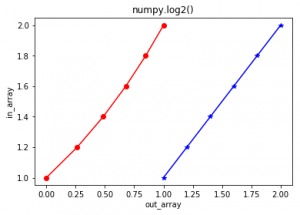numpy.log2(arr,out =無,*,其中= True,強製轉換='same_kind',order ='K',dtype = None,ufunc'log1p'):
此數學函數可幫助用戶計算x的以2為底的對數,其中x屬於所有輸入數組元素。
參數:
array : [array_like]Input array or object.
out : [ndarray, optional]Output array with same dimensions as Input array,
placed with result.
**kwargs : Allows you to pass keyword variable length of argument to a function.
It is used when we want to handle named argument in a function.
where : [array_like, optional]True value means to calculate the universal
functions(ufunc) at that position, False value means to leave the
value in the output alone.
返回:
An array with Base-2 logarithmic value of x; where x belongs to all elements of input array.
代碼1:工作
# Python program explaining
# log2() function
import numpy as np
in_array = [1, 3, 5, 2**8]
print ("Input array : ", in_array)
out_array = np.log2(in_array)
print ("Output array : ", out_array)
print("\nnp.log2(4**4) : ", np.log2(4**4))
print("np.log2(2**8) : ", np.log2(2**8))輸出:
Input array : [1, 3, 5, 256] Output array : [ 0. 1.5849625 2.32192809 8. ] np.log2(4**4) : 8.0 np.log2(2**8) : 8.0
代碼2:圖形表示
# Python program showing
# Graphical representation of
# log2() function
import numpy as np
import matplotlib.pyplot as plt
in_array = [1, 1.2, 1.4, 1.6, 1.8, 2]
out_array = np.log2(in_array)
print ("out_array : ", out_array)
plt.plot(in_array, in_array, color = 'blue', marker = "*")
# red for numpy.log2()
plt.plot(out_array, in_array, color = 'red', marker = "o")
plt.title("numpy.log2()")
plt.xlabel("out_array")
plt.ylabel("in_array")
plt.show() 輸出:
out_array : [ 0. 0.26303441 0.48542683 0.67807191 0.84799691 1. ]

參考文獻:
https://docs.scipy.org/doc/numpy-1.13.0/reference/generated/numpy.exp.html
。
相關用法
注:本文由純淨天空篩選整理自Mohit Gupta_OMG 大神的英文原創作品 numpy.log2() in Python。非經特殊聲明,原始代碼版權歸原作者所有,本譯文未經允許或授權,請勿轉載或複製。
